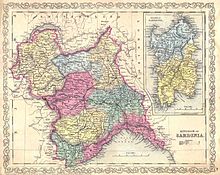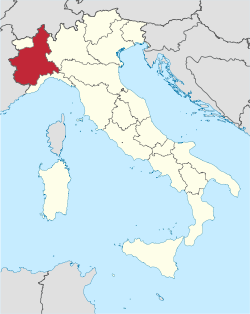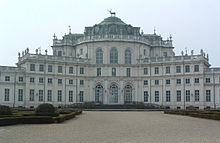| Piedmont Piemonte | |||
|---|---|---|---|
| — Region of Italy — | |||
| |||
| Country | Italy | ||
| Capital | Turin | ||
| Government | |||
| - President | Roberto Cota (LN) | ||
| Area | |||
| - Total | 25,402 km2 (9,807.8 sq mi) | ||
| Population (2010-11-30) | |||
| - Total | 4,456,532 | ||
| - Density | 175.4/km2 (454.4/sq mi) | ||
| Time zone | CET (UTC+1) | ||
| - Summer (DST) | CEST (UTC+2) | ||
| GDP/ Nominal | € 127.0[1] billion (2008) | ||
| NUTS Region | ITC | ||
| Website | www.regione.piemonte.it | ||
Piedmont (Italian: Piemonte, pronounced [pjeˈmonte]; Piedmontese and Occitan: Piemont; French: Piémont) is one of the 20 regions of Italy. It has an area of 25,402 square kilometres and a population of about 4.4 million. The capital of Piedmont is Turin. The main local language is Piedmontese. Occitan is also spoken by a minority in the Occitan Valleys. Franco-Provençal is also spoken by another minority in the alpine heights of the Province of Turin. The name Piedmont comes from medieval Latin Pedemontium or Pedemontis, i. e. "ad pedem montium", meaning "at the foot of the mountains" (attested in documents of the end of the 13th century).[2]
Contents[hide] |
[edit] Geography
Piedmont is surrounded on three sides by the Alps, including Monviso (Mont Vis), where the Po rises, and Monte Rosa. It borders France, Switzerland and the Italian regions of Lombardy, Liguria, Aosta Valley and for a very small fragment with Emilia Romagna. The geography of Piedmont is 43.3% mountainous, along with extensive areas of hills (30.3%) and plains (26.4%). Piedmont is the second largest of Italy's 20 regions, after Sicily. It is broadly contiguous with the upper part of the drainage basin of the river Po, which rises from the slopes of Monviso in the west of the region and is Italy’s largest river. The Po collects all the waters provided within the semicircle of mountains (Alps and Apennines) which surround the region on three sides. From the highest peaks the land slopes down to hilly areas, (not always, though; sometimes there is a brusque transition from the mountains to the plains) and then to the upper, and then the lower the great Padan Plain. The boundary between the first and the second is characterised by risorgive, springs typical of the pianura padana which supply fresh water both to the rivers and to a dense network of irrigation canals. The countryside, then, is very varied: one passes from the rugged peaks of the massifs of Monte Rosa and of Gran Paradiso (national park), to the damp rice paddies of the Vercellese and Novarese; from the gentle hillsides of the Langhe and of Montferrat to the plains. The percentage of the territory which is a protected area is 7.6%. There are 56 different national or regional parks. One such park is the Gran Paradiso National Park (Grand Paradis).
[edit] History
Piedmont was inhabited in early historic times by Celtic-Ligurian tribes such as the Taurini and the Salassi. They were later submitted by the Romans (c. 220 BC), who founded several colonies there including Augusta Taurinorum (Turin) and Eporedia (Ivrea). After the fall of the Western Roman Empire, the region was repeatedly invaded by the Burgundians, the Goths (5th century), Byzantines, Lombards (6th century), Franks (773). In the 9th-10th centuries there were further incursions by the Magyars and Saracens. At the time Piedmont, as part of the Kingdom of Italy within the Holy Roman Empire, was subdivided into several marks and counties.

In 1046, Oddo of Savoy added Piedmont to their main territory of Savoy, with a capital at Chambéry (now in France). Other areas remained independent, such as the powerful comuni (municipalities) of Asti and Alessandria and the marquisates of Saluzzo and Montferrat. The County of Savoy was elevated to a duchy in 1416, and Duke Emanuele Filiberto moved the seat to Turin in 1563. In 1720, the Duke of Savoy became King of Sardinia, founding what evolved into the Kingdom of Sardinia-Piedmont and increasing Turin's importance as a European capital.
The Republic of Alba was created in 1796 as a French client republic in Piedmont before the area was annexed by France in 1801. In June 1802 a new client republic, the Subalpine Republic, was established in Piedmont and in September it was also annexed. In the congress of Vienna, the Kingdom of Sardinia-Piedmont was restored, and furthermore received the Republic of Genoa to strengthen it as a barrier against France.
Piedmont was an initial springboard for Italy's unification in 1859-1861, following earlier unsuccessful wars against the Austrian Empire in 1820-1821 and 1848-1849. This process is sometimes referred to as Piedmontisation. However, the efforts were later contradicted by efforts of rural farmers.[3][4] The House of Savoy became Kings of Italy, and Turin briefly became the capital of Italy. However, the addition of territory paradoxically reduced Piedmont's importance to the kingdom, and the capital was moved to Florence, and then to Rome. One remaining recognition of Piedmont's historical role was that the crown prince of Italy was known as the Prince of Piedmont.
[edit] Economy
Lowland Piedmont is a fertile agricultural region. The main agricultural products in Piedmont are cereals, including rice, representing more than 10% of national production, maize, grapes for wine-making and fruit and milk.[5] With more than 800,000 head of cattle in 2000, livestock production accounts for half of final agricultural production in Piedmont. Piedmont is one of the great winegrowing regions in Italy. More than half of its 700 square kilometres (170,000 acres) of vineyards are registered with DOC designations. It produces prestigious wines as Barolo, Barbaresco, from the Langhe near Alba, and the Moscato d'Asti (as well as the sparkling Asti Spumante) from the vineyards around Asti. Indigenous grape varieties include Nebbiolo, Barbera, Dolcetto, Freisa, Grignolino and Brachetto.
The region contains major industrial centres, notably: Ivrea, home to the Olivetti; Turin, home to the FIAT automobile works. Biella produces tissues and silks. Asti comune about 55 kilometres east of Turin in the plain of the Tanaro River and one of the most important center of Monferrato which is one of the best known Italian wine districts in the world.[6] Alba is the house of Ferrero's chocolate factories and some mechanical industries. There are links with neighbouring France via the Fréjus and Colle di Tenda tunnels and the Montgenèvre Pass, and with Switzerland over the Simplón and Great St Bernard passes. It is possible to get to Switzerland via a normal road, that crosses the Oriental Piedmont starting from Arona up to Locarno, on the borders with Italy. The region's airport, Turin-Caselle, caters for domestic and international flights.[5] The region has the longest motorways network amongst the Italian regions (about 800 km). The motorway routes radiate from Turin, connecting it with the other provinces in the Piemonte region, as well as with the other regions in Italy. In 2001, the number of passenger cars per 1,000 inhabitants at 623 was above the national average (575).[5]

The tourism industry in Piedmont employs 75,534 people and currently comprises 17,367 companies operating in the hospitality and catering sector, with 1,473 hotels and tourist accommodations. The sector generates a turnover of €2,671 million Euros, 3.3% of the €80,196 million which represents the total estimated spending on tourism in Italy. The region enjoys almost the same level of popularity among Italians and visitors from overseas. In 2002, there were 2,651,068 total arrivals; international visitors to Piedmont in 2002 accounted for 42% of the total number of tourists with 1,124,696 arrivals. The traditional leading areas for tourism in Piedmont are the Lake District – "Piedmont's riviera", which accounts for 32.84% of total overnight stays, and the metropolitan area of Turin which accounts for 26.51.[7] In 2006 Turin hosted the XX Olympic Winter Games and in 2007 the XXIII Universiade. Alpine tourism tends to concentrate in a few highly developed stations like Alagna Valsesia and Sestriere. Around 1980, the long-distance trail Grande Traversata delle Alpi has been created to draw more attention to the manyfold of remote, sparsely inhabited valleys.
Since 2006, the Piedmont region has also benefited from the start of the Slow Food movement, and Terra Madre, events that have highlighted the rich agricultural and vinicultural value of the Po valley and northern Italy. In the same year, Piemonte Agency for Investments, Export and Tourism was founded in order to strengthen the international role of the area and its potential. It was the first Italian institution bringing together all activities carried out by pre-existing local organizations operating for the internationalization of the territory.
[edit] Education in Piedmont

The economy of Piedmont is anchored on a rich history of state support for excellence in higher education, including some of the leading universities in Italy. The Piedmont valley is home to the famous University of Turin, the Polytechnic University of Turin and, more recently, the University of Eastern Piedmont.
[edit] Demographics
| Historical populations | ||
|---|---|---|
| Year | Pop. | %± |
| 1861 | 2,759,000 | — |
| 1871 | 2,928,000 | 6.1% |
| 1881 | 3,090,000 | 5.5% |
| 1901 | 3,319,000 | 7.4% |
| 1911 | 3,414,000 | 2.9% |
| 1921 | 3,439,000 | 0.7% |
| 1931 | 3,458,000 | 0.6% |
| 1936 | 3,418,000 | −1.2% |
| 1951 | 3,518,000 | 2.9% |
| 1961 | 3,914,000 | 11.3% |
| 1971 | 4,432,000 | 13.2% |
| 1981 | 4,479,000 | 1.1% |
| 1991 | 4,303,000 | −3.9% |
| 2001 | 4,215,000 | −2.0% |
| 2010 (Est.) | 4,456,000 | 5.7% |
| Source: ISTAT 2001 | ||
The population density in Piemonte is lower than the national average. In 2008 it was equal to 174 inhabitants per km2, compared to a national figure of about 200. It rises however to 335 inhabitants per km2 when just the province of Turin is considered, whereas Verbano-Cusio-Ossola is the less densely populated province (72 inhabitants per km2). The population of Piedmont followed a downward trend throughout the 1980s. This drop is the result of the natural negative balance (of some 3 to 4% per year), while the migratory balance since 1986 has again become positive because of an excess of new immigration over a stable figure for emigration.[8] The population as a whole has remained stable in the 1990s, although this is the result of a negative natural balance and a positive net migration.
The Turin metro area grew rapidly in the 1950s and 1960s due to an increase of immigrants from Southern Italy, and today it has a population of approximately two million. As of 2008, the Italian national institute of statistics (ISTAT) estimated that 310,543 foreign-born immigrants live in Piedmont, equal to 7.0% of the total regional population.
[edit] Government and politics
At the April 2008 Italian national election, Piedmont gave 46.8% of its votes to the Centre-Right coalition led by Silvio Berlusconi.
The Regional Government (Giunta Regionale) is presided by the President of the Region (Presidente della Regione), who is elected for a five-year term and is composed by the President and the Ministers, who are currently 14, including a Vice President (Vice Presidente).[9] In the last regional election, which took place on 29–30 March 2010, Roberto Cota (Lega Nord), defeated incumbent Mercedes Bresso (Democratic Party).
[edit] Administrative divisions-(copy of wikipedia)
Piedmont is divided into eight provinces:
| Province | Area (km²) | Population | Density (inh./km²) |
|---|---|---|---|
| Province of Alessandria | 3,560 | 438,062 | 123.1 |
| Province of Asti | 1,504 | 219,629 | 146.0 |
| Province of Biella | 913 | 187,090 | 204.9 |
| Province of Cuneo | 6,903 | 584,467 | 84.7 |
| Province of Novara | 1,339 | 365,156 | 272.7 |
| Province of Turin | 6,821 | 2,288,614 | 335.5 |
| Province of Verbano-Cusio-Ossola | 2,255 | 162,618 | 72.1 |
| Province of Vercelli | 2,088 | 179,164 | 85.8 |







No comments:
Post a Comment